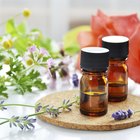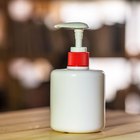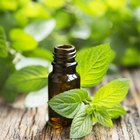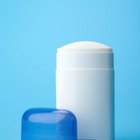Make your own foaming hand sanitizer. If you choose to use alcohol, make sure the sanitizer contains at least 60% alcohol in order to be effective. Many homemade recipes circulating on the web call for much less alcohol and this makes them ineffective as germ killers, according to an article in the New York Times. One benefit to making your own hand sanitizer is being able to customize it to your needs.
The Facts Behind Sanitizers
Hand sanitizers work effectively because of the alcohol content. The alcohol content needs to be at least 60% to be effective, unless you want to try an all-natural version using vinegar and lemon juice as the active ingredients. Hand sanitizers also need hands free of blood, dirt or other mess in order to be effective. If the hands are visibly dirty, they need to be washed first, then treated with hand sanitizer. Foaming hand sanitizers are convenient. The foaming mechanism is hard to duplicate at home. But by purchasing one bottle of anything in a foaming dispenser, you can use the bottle again and again. You will notice that you use much less sanitizer this way.
The Foam Dispenser
The actual foam dispenser is a great way for soap companies to sell less soap for more money. You will notice that if you are refilling your foaming soap dispenser, you must fill it with about one centimeter of soap and the rest of the bottle with water. Any more soap and the dispenser will not work properly. If you do not use your soap quickly enough, a slime will form, which will make the dispenser stop working. All commercial brands of liquid soap contain ingredients that make it foam.
The Recipe
To make your sanitizer work, you will need a foaming dispenser, a small amount of liquid soap, and alcohol. Fill your bottle with ½ centimeter (about 1/4 inch) liquid hand soap and fill the rest of the bottle with isopropyl alcohol. You may even need less soap. Foaming hand dispensers vary in how much soap is necessary, so experiment a bit.
A Natural Alternative
A study in the International Journal of Food Microbiology showed that lemon and vinegar were nearly as effective at reducing salmonella as alcohol. If you would like a natural alternative hand sanitizer, you could try filling your foam dispenser with a very small amount of liquid soap, with the rest of the bottle filled with a mixture of half lemon juice and half vinegar.
Related Articles

The Effectiveness of Purell

How to Make Antibacterial Soap

How Does Homemade Soap Compare to ...

How to Make Homemade Liquid Rouge

How Does Soap Kill Germs?

How to Make All-Natural Hand Sanitizer

How to Use Shower Gel for a Bubble Bath

How to Make Your Own Oxygenating ...

What Is a Substitute for Cherry Liqueur?

How to Add Citric Acid to Castile Soap

Homemade Bay Rum Soap Recipe

Facts About Hand Sanitizers

Calories in Peppermint Extract

How to Calculate Alcohol Content in Wine

The Benefits of Castile Soap

Effectiveness of Non-Alcohol Hand ...

List of Soaps for Acne

How to Make the most Effective Homemade ...

Can You Thicken Alcohol With Gelatin?

Glycerin Uses
References
Writer Bio
Christopher Hall founded and published a magazine which was sold on newsstands across the United States and Canada. Since 1995, his work has been featured in magazines such as "Massage Magazine," "Fitness Link," "B.C. Parent" and "Toddler's Today." Currently, he is pursuing his master's degree.